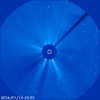SOLAR CYCLE 25 ACTIVITY REPORT JANUARY 06_2023

● Auroral Activity
Aurora Oval Bz: -0.15 nT South

● Current Conditions at 04:30 UTC on January 06
▪︎ Geospace quiet (Kp 1)
▪ Solar wind speed record: 475 km/sec (Elevated speed)
▪︎ density: 4.35 p/cm³ (low density)
▪︎ Interplanetary Magnetic Field (IMF)
Bt: 2.68 nT
▪︎ X-ray Solar Flare: C1 0308 UT Jan06
▪︎ Thermosphere Climate Index
today: 19.78x1010 W Warm
▪︎ Neutron Counts today: - 5 % (Low)
▪︎ Sunspot number: 121 (SN 64 January 05)
▪︎ Spotless Days 2023 total: 0 days (0%)
• Solar wind flowing from this minor coronal hole could graze Earth's magnetic field on Jan. 9th.

.........
SpaceWeatherlive.com
SpaceWeather.com
Solar activity has been at low levels for the past 24 hours. The largest solar event of the period was a C3 event observed at 0809 UTC from Region 3534 (S15W61).
The sun in 2023 (1 year in 30 seconds)
There are currently 8 sunspot regions on the solar disk: AR3534, AR3536, AR3537, AR3538 and new regions AR3539, AR3540, AR3541, AR3542
The sun in 2023 (1 year in 30 seconds)
There are currently 8 sunspot regions on the solar disk: AR3534, AR3536, AR3537, AR3538 and new regions AR3539, AR3540, AR3541, AR3542
Total number of sunspots has increased to 121 (41 of these are grouped into 8 active regions) NOAA forecasts for the next 24h: 95% chance for C flares, 35% chance M flares and 10% chance for X flares.
AR3536 continues with delta-class magnetic field that poses a threat for strong X-class solar flares while the remaining regions have a stable magnetic field.
AR3536 continues with delta-class magnetic field that poses a threat for strong X-class solar flares while the remaining regions have a stable magnetic field.
SOLAR MAX IS COMING: Since Solar Cycle 25 began in Dec. 2019, 782 sunspot groups have crossed the face of the sun. Almost half (361) appeared in 2023. This montage assembled by Ali Ebrahimi Seraji of the Mahani Observatory in Iran shows how sunspot production has skyrocketed:
"I created this 4-year overview using images from NASA's Solar Dynamics Observatory," says Seraji. "The graph beneath the images is from NOAA; it shows actual monthly sunspot counts (white) vs. predictions (blue). The sun is outperforming the forecast."
Many forecasters believe that Solar Max will occur in 2024. That means we can expect *even more* sunspots this year. Solar flare, geomagnetic storms and auroras are in the offing.
● Auroral Activity
The geomagnetic field has been at quiet to unsettled levels for the past 24 hours. On January 05 Solar wind speed reached a peak of 504 km/s (Moderately high speed) at 12:09 UTC. No significant impact occurred to the magnetic field.
Aurora Oval Bz: -0.15 nT South
● Current Conditions at 04:30 UTC on January 06
▪︎ Geospace quiet (Kp 1)
▪ Solar wind speed record: 475 km/sec (Elevated speed)
▪︎ density: 4.35 p/cm³ (low density)
▪︎ Interplanetary Magnetic Field (IMF)
Bt: 2.68 nT
▪︎ X-ray Solar Flare: C1 0308 UT Jan06
▪︎ Thermosphere Climate Index
today: 19.78x1010 W Warm
▪︎ Neutron Counts today: - 5 % (Low)
▪︎ Sunspot number: 121 (SN 64 January 05)
▪︎ Spotless Days 2023 total: 0 days (0%)
• Solar wind flowing from this minor coronal hole could graze Earth's magnetic field on Jan. 9th.
.........
SpaceWeatherlive.com
SpaceWeather.com








